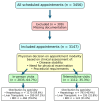Telemedicine Hybrid Care Models in Gastroenterology Outpatient Care: Results from a German Tertiary Center
- PMID: 40217919
- PMCID: PMC11989252
- DOI: 10.3390/jcm14072471
Telemedicine Hybrid Care Models in Gastroenterology Outpatient Care: Results from a German Tertiary Center
Abstract
Background: With the COVID-19 pandemic, a rapid adoption of telemedicine became necessary. Data regarding its implementation in specialized hepatology/IBD care remain limited. This study evaluated telemedicine's effectiveness and safety during the pandemic at a German tertiary center and explored its integration into future hybrid care models. Methods: In a retrospective study, we analyzed 3147 patient encounters at the outpatient clinic of the Department for Gastroenterology and Hepatology at the University Hospital Frankfurt between March and June 2020. We assessed patient characteristics, appointment adherence, and outcomes across the three specialized clinics: hepatology (n = 1963), liver transplant (n = 594), and IBD (n = 590). Multivariate regression analysis identified predictors of successful telemedicine utilization. Results: Out of all appointments, 1112 (35.3%) were conducted via telemedicine, with significantly different adoption rates across clinics (hepatology, 40.4%; liver transplant, 32.8%; IBD, 21.0%, p < 0.01). Adherence rates were comparable between telemedicine (91.3%) and in-person visits (90.5%). Multivariate analysis identified age (OR 1.009, 95%CI 1.004-1.014, p < 0.001), metabolic-associated steatotic liver disease (OR 1.737, 95%CI 1.400-2.155, p < 0.001), and post-liver transplant status (OR 1.281, 95%CI 1.001-1.641, p = 0.049) as independent predictors of successful telemedicine utilization. HBV/HDV coinfection (OR 0.370, 95%CI 0.192-0.711, p = 0.003) and required endoscopy (OR 0.464, 95%CI 0.342-0.630, p < 0.001) were associated with in-person care. Hospitalization rates were low and comparable across modalities, confirming telemedicine's safety. Conclusions: This study demonstrates that telemedicine can be successfully implemented in specialized gastroenterology and hepatology care, with high compliance rates comparable to in-person visits. Patient characteristics and disease-specific factors influence the suitability for telemedicine, supporting a stratified approach to hybrid care models, which can optimize resource utilization while maintaining quality of care. Particularly stable MASLD patients, well-controlled post-transplant recipients beyond one year, and IBD patients in sustained remission can be properly managed through telemedicine with annual in-person assessments.
Keywords: hybrid care; pandemic; telemedicine.
Conflict of interest statement
SZ: speaker’s bureau and/or consultancy: Abbvie, BioMarin, Boehringer Ingelheim, Gilead, GSK, Ipsen, Madrigal, MSD, NovoNordisk, and SoBi. All are unrelated to the presented work.
Figures



Similar articles
-
Positive impact of the pandemic: the effect of post-COVID-19 virtual visit implementation on departmental efficiency and patient satisfaction in a quaternary care center.Neurosurg Focus. 2022 Jun;52(6):E10. doi: 10.3171/2022.3.FOCUS2243. Neurosurg Focus. 2022. PMID: 35921181
-
Factors Associated With the Utilization of Outpatient Virtual Clinics: Retrospective Observational Study Using Multilevel Analysis.J Med Internet Res. 2022 Aug 12;24(8):e40288. doi: 10.2196/40288. J Med Internet Res. 2022. PMID: 35917486 Free PMC article.
-
Successful Distancing: Telemedicine in Gastroenterology and Hepatology During the COVID-19 Pandemic.Dig Dis Sci. 2021 Apr;66(4):945-953. doi: 10.1007/s10620-021-06874-x. Epub 2021 Mar 3. Dig Dis Sci. 2021. PMID: 33655456 Free PMC article. Review.
-
Telemedicine at a University Ophthalmology Practice During the Beginning of the COVID-19 Pandemic.Clin Ophthalmol. 2024 Aug 23;18:2369-2380. doi: 10.2147/OPTH.S460454. eCollection 2024. Clin Ophthalmol. 2024. PMID: 39193320 Free PMC article.
-
A narrative review of telemedicine and its adoption across specialties.Mhealth. 2024 Apr 15;10:19. doi: 10.21037/mhealth-23-28. eCollection 2024. Mhealth. 2024. PMID: 38689613 Free PMC article. Review.
References
-
- Bohmer M.M., Buchholz U., Corman V.M., Hoch M., Katz K., Marosevic D.V., Bohm S., Woudenberg T., Ackermann N., Konrad R., et al. Investigation of a COVID-19 outbreak in Germany resulting from a single travel-associated primary case: A case series. Lancet Infect Dis. 2020;20:920–928. doi: 10.1016/S1473-3099(20)30314-5. - DOI - PMC - PubMed
-
- Priesemann V., Brinkmann M.M., Ciesek S., Cuschieri S., Czypionka T., Giordano G., Gurdasani D., Hanson C., Hens N., Iftekhar E., et al. Calling for pan-European commitment for rapid and sustained reduction in SARS-CoV-2 infections. Lancet. 2021;397:92–93. doi: 10.1016/S0140-6736(20)32625-8. - DOI - PMC - PubMed
LinkOut - more resources
Full Text Sources

